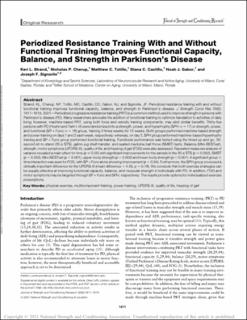| dc.description.abstract | Periodized progressive resistance training (PRT) is a common method used to improve strength in persons with Parkinson's disease (PD). Many researchers advocate the addition of functional training to optimize translation to activities of daily living; however, machine-based PRT, using both force and velocity training components, may elicit similar benefits. Thirty-five persons with PD (Hoehn and Yahr I–III) were randomized into a strength, power, and hypertrophy (SPH; n = 17) or strength, power, and functional (SP + Func; n = 18) group, training 3 times weekly for 12 weeks. Both groups performed machine-based strength and power training on days 1 and 2 each week, respectively; whereas, on day 3, SPH group performed machine-based hypertrophy training and SP + Func group performed functional training. Functional performance was tested using the timed up and go, 30-second sit-to-stand (30-s STS), gallon-jug shelf-transfer, and seated medicine ball throw (SMBT) tests. Balance (Mini-BESTest), strength, motor symptoms (UPDRS-III), quality of life, and freezing of gait (FOG) were also assessed. Repeated measures analysis of variance revealed a main effect for time (p ≤ 0.05) with significant improvements for the sample in the 30-s STS (p = 0.002), SMBT (p = 0.003), Mini-BESTest (p < 0.001), upper-body strength (p = 0.002) and lower-body strength (p < 0.001). A significant group × time interaction was seen for FOG, with SP + Func alone showing improvement (p = 0.04). Furthermore, the SPH group produced a clinically important difference for the UPDRS-III (mean difference = 4.39, p = 0.18). We conclude that both exercise strategies can be equally effective at improving functional capacity, balance, and muscular strength in individuals with PD. In addition, FOG and motor symptoms may be targeted through SP + Func and SPH, respectively. The results provide options for individualized exercise prescriptions. | en_US |
